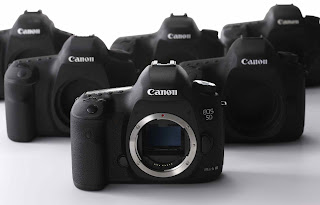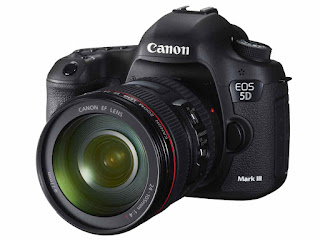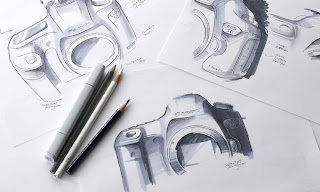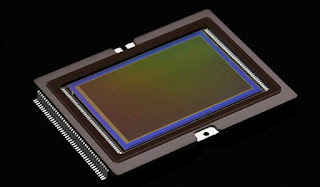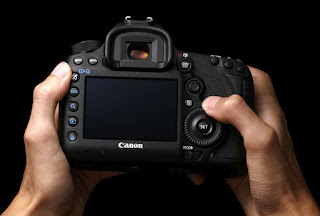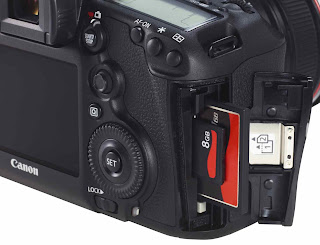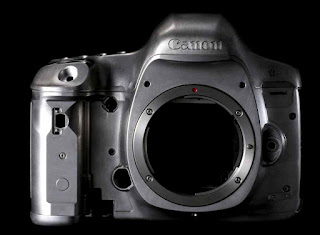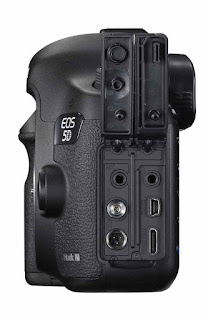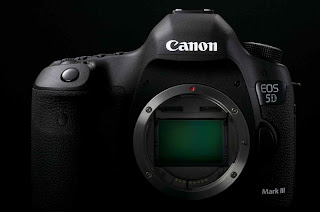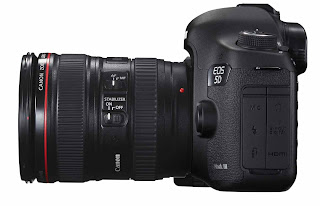http://urbanfoxtv.blogspot.com/search/label/Canon 5D Mark III
Canon EOS 5D Mark III launched
Three-and-a-half years ago, Canon kick-started the large sensor revolution with its full-frame DSLR, the EOS 5D Mark II. Since then it has been used on numerous TV dramas, such as House, and other productions to achieve shallow depth of field. Now Canon has introduced the 5D Mark III, which addresses most of the Mark II’s problems.
While the 5D Mark III isn’t the huge leap forward that some users had expected, it does have all the video features previously announced for the up-coming EOS-1D X, but at about half the price, and adds a headphone jack for audio monitoring.
It can record using either interframe or intra-frame compression. The interframe IPB AVC H.264 compression is apparently about 31Mbps (according to the Canon USA website figure of 235MB/min - the 5D Mark II was about 38-40Mbps). However, it has been reported elsewhere as 50Mbps (variable bitrate). The ALL-I intra-frame codec has been reported variously as being 78Mbps, 91Mbps (from the 685MB/min on Canon's US site), and even 300Mbps+ (although maybe that was just the recommended specification for the Compact Flash card). It too is a variable bit rate, and also varies depending on frame rate (going to 81Mbps for 720/60p). However, if we take 91Mbps as correct, that is not necessarily sufficiently better than the Long GoP (group of pictures) interframe compression for broadcast work. The BBC/EBU recommendation for minimum bit rate for interframe is 50Mbps, while for intra-frame recording it is 100Mbps (see What makes an HD camera?) - interframe recording is a lot more efficient than recording all the frames individually, although intra-frame should be easier for post production as the computer doesn't have to look at half-a-second's worth of video just to decode a single frame.
It will shoot 1080 at 24, 25 or 30p, plus 720 at 50/60p (at variable frame rates). There has been a lot of griping that it doesn't do 1080 at 50/60p, but there aren't many professional video cameras that do 50/60p at a decent bit rate, so it's a bit much to expect a relatively low-cost DSLR to do it.
According to Canon, “the new full-frame sensor combines with the vast processing power of DIGIC 5+ [processor] to improve image quality by virtually eradicating the presence of moiré, false colour and other artefacts,” which was the principle problem with the Mark II. In the initial videos released by Canon, these artefacts don’t appear to be noticeable (although the sample online videos are too compressed to make an accurate judgement). There still seem to be some rolling shutter effects (jello), but this appears to be much reduced compared to the Mark II.
Other video related changes include the addition of a movie mode switch and a recording button (similar to the 7D), which enables users to begin shooting immediately when movie mode is engaged (and also allows two completely different settings for movie and stills modes), and locks to prevent accidental exposure changes (something that was a paid upgrade for the Mark II). The rear control wheel is now touch sensitive, so you can make light-fingered adjustments as you are shooting without potentially knocking the camera. Users can also check and adjust audio during recording via the camera’s Quick Control screen. It also adds free-run and rec-run timecode support.
The camera is also considerably better in low light than the Mark II (which was itself a pretty good performer in low light), by about two stops.
There are two card slots (for SD and Compact Flash cards) and users can record to both cards simultaneously, or automatically switch from one to the other when the first card is full. Instead of the 4GB limit per recording (which amounted to about 12 minutes on the Mark II), the Mark III can record up to 29 minutes 59 seconds without pause, as the camera seamlessly connects the 4GB files.
The magnesium body is apparently more weatherproof and durable than the Mark II. It also has a better LCD, using the 3.2-inch 1.04million-dot screen from the 1D X.
One problem with the Mark II that wasn’t addressed was the HDMI output, which still doesn’t produce a clean signal, so can’t be recorded on an external recorder, although the Mark III no longer reduces the resolution to 480p via HDMI when recording starts (which will be better for anyone using an add-on monitor).
Canon now faces a lot more competition than it did in November 2008. The Nikon D800, which should start shipping before April, is the obvious full-frame, full-HD rival, and it will allow a clean HDMI feed for external recording – although not the adjustable audio levels, frame rates above 30fps or higher bitrate in-camera recording of the Mark III (the D800 is limited to 24Mbps).
Canon’s own EOS C300 is a much lauded large-sensor (APS-C/Super 35mm size) video camera, which looks good in low light. And there are now a wide range of large-sensor video cameras that are relatively inexpensive (at least by the standards of a few years ago), from Arri’s Alexa to Sony’s F65, F3 and FS100, and Panasonic’s AF101. At the lowest budget end, Panasonic’s GH2 DSLR can produce lovely-looking video (once it has been loaded with the independent Driftwood hack that allows it record at up to 176Mbps).
At the C300 launch, Canon also promised to introduce a new 4K Cinema EOS full-frame DSLR camera by the end of this year, which may be a further consideration.
“The EOS 5D Mark III represents a big step forward for the EOS 5D series,” said Kieran Magee, Marketing Director, Professional Imaging, Canon Europe.
It “is an exceptional camera and we’ve listened carefully to feedback from its passionate community of users to improve performance in every area. This camera has been designed to meet virtually any creative challenge – it’s faster, more responsive and features the tools to adapt to everything from studio photography to creative videography, while producing results of the highest quality,” he claimed.
The EOS 5D Mark III will be available from end of March 2012, with a list price of £3,000 / €3,570 including VAT, or $3,500.
By David Fox
Canon EOS 5D Mark III launched
Three-and-a-half years ago, Canon kick-started the large sensor revolution with its full-frame DSLR, the EOS 5D Mark II. Since then it has been used on numerous TV dramas, such as House, and other productions to achieve shallow depth of field. Now Canon has introduced the 5D Mark III, which addresses most of the Mark II’s problems.
While the 5D Mark III isn’t the huge leap forward that some users had expected, it does have all the video features previously announced for the up-coming EOS-1D X, but at about half the price, and adds a headphone jack for audio monitoring.
It can record using either interframe or intra-frame compression. The interframe IPB AVC H.264 compression is apparently about 31Mbps (according to the Canon USA website figure of 235MB/min - the 5D Mark II was about 38-40Mbps). However, it has been reported elsewhere as 50Mbps (variable bitrate). The ALL-I intra-frame codec has been reported variously as being 78Mbps, 91Mbps (from the 685MB/min on Canon's US site), and even 300Mbps+ (although maybe that was just the recommended specification for the Compact Flash card). It too is a variable bit rate, and also varies depending on frame rate (going to 81Mbps for 720/60p). However, if we take 91Mbps as correct, that is not necessarily sufficiently better than the Long GoP (group of pictures) interframe compression for broadcast work. The BBC/EBU recommendation for minimum bit rate for interframe is 50Mbps, while for intra-frame recording it is 100Mbps (see What makes an HD camera?) - interframe recording is a lot more efficient than recording all the frames individually, although intra-frame should be easier for post production as the computer doesn't have to look at half-a-second's worth of video just to decode a single frame.
It will shoot 1080 at 24, 25 or 30p, plus 720 at 50/60p (at variable frame rates). There has been a lot of griping that it doesn't do 1080 at 50/60p, but there aren't many professional video cameras that do 50/60p at a decent bit rate, so it's a bit much to expect a relatively low-cost DSLR to do it.
According to Canon, “the new full-frame sensor combines with the vast processing power of DIGIC 5+ [processor] to improve image quality by virtually eradicating the presence of moiré, false colour and other artefacts,” which was the principle problem with the Mark II. In the initial videos released by Canon, these artefacts don’t appear to be noticeable (although the sample online videos are too compressed to make an accurate judgement). There still seem to be some rolling shutter effects (jello), but this appears to be much reduced compared to the Mark II.
Other video related changes include the addition of a movie mode switch and a recording button (similar to the 7D), which enables users to begin shooting immediately when movie mode is engaged (and also allows two completely different settings for movie and stills modes), and locks to prevent accidental exposure changes (something that was a paid upgrade for the Mark II). The rear control wheel is now touch sensitive, so you can make light-fingered adjustments as you are shooting without potentially knocking the camera. Users can also check and adjust audio during recording via the camera’s Quick Control screen. It also adds free-run and rec-run timecode support.
The camera is also considerably better in low light than the Mark II (which was itself a pretty good performer in low light), by about two stops.
There are two card slots (for SD and Compact Flash cards) and users can record to both cards simultaneously, or automatically switch from one to the other when the first card is full. Instead of the 4GB limit per recording (which amounted to about 12 minutes on the Mark II), the Mark III can record up to 29 minutes 59 seconds without pause, as the camera seamlessly connects the 4GB files.
The magnesium body is apparently more weatherproof and durable than the Mark II. It also has a better LCD, using the 3.2-inch 1.04million-dot screen from the 1D X.
One problem with the Mark II that wasn’t addressed was the HDMI output, which still doesn’t produce a clean signal, so can’t be recorded on an external recorder, although the Mark III no longer reduces the resolution to 480p via HDMI when recording starts (which will be better for anyone using an add-on monitor).
Canon now faces a lot more competition than it did in November 2008. The Nikon D800, which should start shipping before April, is the obvious full-frame, full-HD rival, and it will allow a clean HDMI feed for external recording – although not the adjustable audio levels, frame rates above 30fps or higher bitrate in-camera recording of the Mark III (the D800 is limited to 24Mbps).
Canon’s own EOS C300 is a much lauded large-sensor (APS-C/Super 35mm size) video camera, which looks good in low light. And there are now a wide range of large-sensor video cameras that are relatively inexpensive (at least by the standards of a few years ago), from Arri’s Alexa to Sony’s F65, F3 and FS100, and Panasonic’s AF101. At the lowest budget end, Panasonic’s GH2 DSLR can produce lovely-looking video (once it has been loaded with the independent Driftwood hack that allows it record at up to 176Mbps).
At the C300 launch, Canon also promised to introduce a new 4K Cinema EOS full-frame DSLR camera by the end of this year, which may be a further consideration.
“The EOS 5D Mark III represents a big step forward for the EOS 5D series,” said Kieran Magee, Marketing Director, Professional Imaging, Canon Europe.
It “is an exceptional camera and we’ve listened carefully to feedback from its passionate community of users to improve performance in every area. This camera has been designed to meet virtually any creative challenge – it’s faster, more responsive and features the tools to adapt to everything from studio photography to creative videography, while producing results of the highest quality,” he claimed.
The EOS 5D Mark III will be available from end of March 2012, with a list price of £3,000 / €3,570 including VAT, or $3,500.
By David Fox

